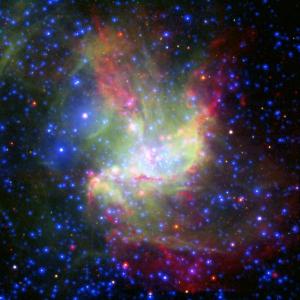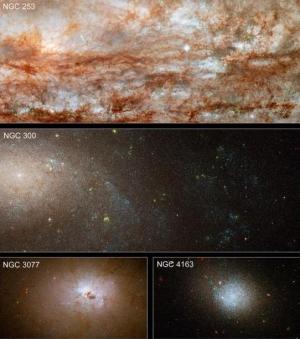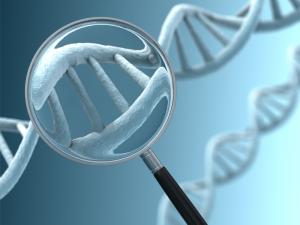Telescopes on the ground and in space have teamed up to compose a colourful image that offers a fresh look at the history of the star-studded region NGC 346. This new, ethereal portrait, in which different wavelengths of light swirl together like watercolours, reveals new information about how stars form.

© ESO/ESA/JPL-Caltech/NASA/D. Gouliermis (MPIA) et al.This new portrait of the bright star-forming region NGC 346, in which different wavelengths of light swirl together like watercolours, reveals new information about how stars form. NGC 346 is located 210 000 light-years away in the Small Magellanic Cloud, a neighbouring dwarf galaxy of the Milky Way. The image is based on data from ESA XMM-Newton (X-rays; blue), ESO's New Technology Telescope (visible light; green), and NASA's Spitzer (infrared; red). The infrared light shows cold dust, while the visible light denotes glowing gas, and the X-rays represent very hot gas. Ordinary stars appear as blue spots with white centres, while young stars enshrouded in dust appear as red spots with white centres.
The picture combines infrared, visible and X-ray light from NASA's Spitzer Space Telescope, ESO's New Technology Telescope (NTT) and the European Space Agency's XMM-Newton orbiting X-ray telescope, respectively. The NTT visible-light images allowed astronomers to uncover glowing gas in the region and the multi-wavelength image reveals new insights that appear only thanks to this unusual combination of information.
NGC 346 is the brightest star-forming region in the Small Magellanic Cloud, an irregular dwarf galaxy that orbits the Milky Way at a distance of 210 000 light-years.
"NGC 346 is a real astronomical zoo," says Dimitrios Gouliermis of the Max Planck Institute for Astronomy in Heidelberg, Germany, and lead author of the paper describing the observations. "When we combined data at various wavelengths, we were able to tease apart what's going on in different parts of this intriguing region."


